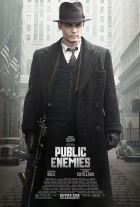Public Enemies
|  As indicated by its title, which is taken from a rigorously researched nonfiction book by Bryan Burrough, but immediately calls to mind William Wellman’s rip-roaring 1931 film classic of a similar name, Michael Mann’s Public Enemies is a cool and calculated throwback to the romanticized heyday of gangster films, when hard-nosed actors like James Cagney and Paul Muni and Edward G. Robinson (the kind of men who didn’t have faces, but rather “mugs”) tore through the silver screen with violent, iconic performances as thinly veiled real-life criminals who were rumored to enjoy watching their screen incarnations in person. Of course, Public Enemies is a more intentionally sophisticated film than those ripped-from-the-headlines programmers, which were so effective that the movie industry literally shut them down because they threatened to popularize criminality. Yet, Chicago-born Mann, who has watched many a movie in the very Biograph Theater on Lincoln Avenue where his film’s (anti)hero John Dillinger was gunned down by police after a 14-month crime spree from 1933 to 1934, is clearly infatuated with the illicit glamour and the allure of the gangster lifestyle, and he can’t help but indulge in some of the very pleasures he’s simultaneously attempting to deconstruct. As indicated by its title, which is taken from a rigorously researched nonfiction book by Bryan Burrough, but immediately calls to mind William Wellman’s rip-roaring 1931 film classic of a similar name, Michael Mann’s Public Enemies is a cool and calculated throwback to the romanticized heyday of gangster films, when hard-nosed actors like James Cagney and Paul Muni and Edward G. Robinson (the kind of men who didn’t have faces, but rather “mugs”) tore through the silver screen with violent, iconic performances as thinly veiled real-life criminals who were rumored to enjoy watching their screen incarnations in person. Of course, Public Enemies is a more intentionally sophisticated film than those ripped-from-the-headlines programmers, which were so effective that the movie industry literally shut them down because they threatened to popularize criminality. Yet, Chicago-born Mann, who has watched many a movie in the very Biograph Theater on Lincoln Avenue where his film’s (anti)hero John Dillinger was gunned down by police after a 14-month crime spree from 1933 to 1934, is clearly infatuated with the illicit glamour and the allure of the gangster lifestyle, and he can’t help but indulge in some of the very pleasures he’s simultaneously attempting to deconstruct.The story opens with its best sequence, an improbable yet wholly convincing jailbreak in which John Dillinger (Johnny Depp), having recently completed nine years in the slammer, arrives at a desolate Indiana penitentiary that is so remote and alien that it looks like it belongs in a science fiction movie, to spring a number of his associates, including John “Red” Hamilton (Jason Clarke), who will become one of his most trusted allies. Mann immediately establishes the scope of his vision, giving us impressive widescreen vistas that Depp commands in slow-tracking close-ups. Mann knows he’s working with a unique movie star who, despite his popularity, hasn’t been given the role of a powerful, commanding character (except those who are clearly insane) since his self-effacing turn as a luminous juvenile bad-boy in Cry-Baby (1990), John Waters’ send-up of ’50s-era JD movies and Elvis musicals. In spirit Depp is still playing the bad boy, except now he’s more grown up and the stakes are higher (tomb-like granite banks instead of games of chicken). With his sharp-etched cheekbones and dark eyes, Depp cuts an impressive figure, especially in the high style of the period clothing, but he also brings an edge of idiosyncrasy to the character that so many others would have lacked. Dillinger was, after all, an Indiana farm boy-turned-notorious criminal who was known for both his ruthlessness in robbing banks with a Tommy gun and the generosity with which he treated the patrons of those banks (the manner in which Mann shoots Depp leaping in slow motion over a counter in one of the film’s early heist sequences is an indicator of the film’s stance toward romanticized criminality). The screenplay, which was penned by Ronan Bennett, Michael Mann, and Ann Biderman, used Bryan Burrough’s Public Enemies: America’s Greatest Crime Wave and the Birth of the FBI, 1933-34 as its backbone, although the screenwriters were more than willing to manipulate the facts and order of events to better suit the film’s dramatic ends (for example, while the opening jailbreak did in fact take place, Dillinger was nowhere near it since he was locked up at the time). However, they do maintain Burrough’s dual focus on the rise of Depression-era organized crime and the development of the nascent federal crime bureau known as the FBI. This gives the film a potentially unwieldy structure, as we shift constantly back and forth between the exploits of Dillinger and his gang and the behind-the-scenes power-brokering that was required for a young, but nevertheless imperious J. Edgar Hoover (Billy Crudup) to build his federal crime-fighting empire. Hoover’s choice of front-man is Melvin Purvis, who is portrayed by Christian Bale as a humorless, steely foot soldier whose determination to get Dillinger outweighs the disorganized bungling of the burgeoning organization for which he works (a major point in Burrough’s book that is given lesser treatment here). Purvis and Dillinger have only one scene together in the film, but it’s emblematic of the differences not only between the two individual characters, but the wider ideologies they represent: While Purvis is calm and focused almost to a fault, Dillinger is loose and wise-cracking. The narrative in Public Enemies takes its cue from Dillinger, rather than Purvis, playing it loose rather than sticking to a rigid structure and method. At times, this results in a film that feels a bit aimless, with scenes that are clearly imparting necessary information, but with so much slack that it’s difficult to discern any sense of importance. This allows the characters to emerge at the expense of narrative tension, and the actors are good enough to make it work, particularly French Oscar winner Marion Cotillard as Billie Frechette, a coat-check girl on whom Dillinger immediately zeroes in and pursues with such heady confidence that she can’t help but be swept up in his stylish zeal. Their scenes together, especially the early ones when Dillinger is attempting to woo her, have the crackling snap of the movies of that era, with sharp, fast dialogue that sounds just right. Cotillard plays Billie as an innocent who loves Dillinger, but remains unstained by his criminality even though, in the film’s most brutal scene, she becomes a victim of the FBI’s new “white gloves off” policy of essentially torturing suspects for information. Her romance with Dillinger, while essential in this regard, remains more of an idea than a passionate escapade, partially because they spend so much of the movie separated. As with Mann’s previous two films, Collateral (2004) and Miami Vice (2006), Public Enemies was shot entirely on high-definition video, this time by cinematographer Dante Spinotti, who first worked with Mann on his 1986 adaptation of Thomas Harris’s Red Dragon. The choice to use video is a natural extension of Mann’s aesthetic, which, ever since The Insider (1999), has focused on erratic framing and powerful editing juxtaposed with smooth camera movements, but here it feels completely at odds with the subject matter. Mann’s limited use of video in Ali (2001) felt right because many of the iconic images from Ali’s heyday we remember through the grainy filter of video, but the world of Depression-era gangsters is one we know only through celluloid, and seeing it rendered in pixels rather than grain somehow feels wrong. Granted, it allows Mann and Spinotti to create some truly luminous images, whose sharpness and high contrast provides an additional edge. Yet, other sequences, particularly an otherwise beautifully executed shoot-out at a remote lodge where Purvis and his men have cornered Dillinger’s gang, come off looking like they were shot with someone’s cell phone. It provides a sense of immediacy, but the visual properties are so associated with the current here and now of the YouTube generation that it pulls us out of the reverie of the time period. Perhaps this was part of Mann’s master plan and a means of visually deconstructing the romanticized travails of a criminal who has been so ensconced in pop-culture lore that he can’t exist anywhere except in some version of pulp tabloids, but it’s also hard not to feel that Mann is simply saddling the material with an aesthetic that he has made his directorial signature, but is fundamentally wrong for it. Copyright ©2009 James Kendrick Thoughts? E-mail James Kendrick All images copyright © Universal Pictures |
Overall Rating: 

 (3)
(3)


